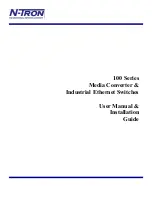
Magnum 6KL Managed Edge Switch Installation and User Guide
11/09
19
www GarrettCom com
.
.
NOTE: for Power Substations:
In support of the IEEE 1613 Class 2 standard, GCI
advises that, for substation applications, the RJ-45 ports are intended for connectivity to
other communication equipment such as routers or telecommunication multiplexers
installed in close proximity (i.e., less than 2 meters or 6.5ft) to the 6KL. It is not
recommended to use these ports in substation applications to interface to field devices
across distances which could produce high (greater than 2500V ) levels of ground
potential rise (GPR) during line-to-ground fault conditions. The 6KL passes the
1613specifications for zero packet loss with fiber ports & with RJ-45 ports used as
indicated here.
3.2.2
Connecting Twisted Pair (CAT5e or better, UTP or STP)
The RJ-45 Gigabit ports of the Magnum 6KL can be connected to the media
types, 1000BASE-T or CAT 5E or better 100-ohm UTP or shielded twisted pair (STP)
balanced cable. The CAT 5E or better 100-ohm UTP or shielded twisted pair (STP)
balanced cable is recommended to use when making 1000BASE-TX connections. In
either case, the max distance for unshielded twisted pair cabling is 100 meters (328 ft).
The following procedure describes how to connect a 1000BASE-T twisted pair segment
to the RJ-45 port. The procedure is the same for both unshielded and shielded twisted
pair cables.
1. 1000BASE-T connections require that all four pairs or wires be connected. Insert
either end of the cable with an RJ-45 plug into the RJ-45 connector of the port.
Note that, even though the connector is shielded, either unshielded or shielded
cables and wiring may be used.
2. Connect the other end of the cable to the corresponding device
3. Use the LINK LED to ensure proper connectivity by noting that the LED will be
illuminated when the unit is powered and proper connection is established
3.2.3
Connecting Single-Mode Fiber Optic
When using single-mode fiber cable, be sure to use single-mode fiber port
connectors. Single-mode fiber cable has a smaller diameter than multi-mode fiber cable
(9/125 microns for single-mode, 50/125 or 62.5/125 microns for multi-mode where xx/xx
are the diameters of the core and the core plus the cladding respectively). Single-mode
fiber allows full bandwidth at longer distances, about 70km with the single-mode LC.
















































